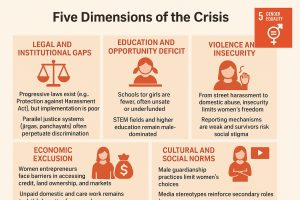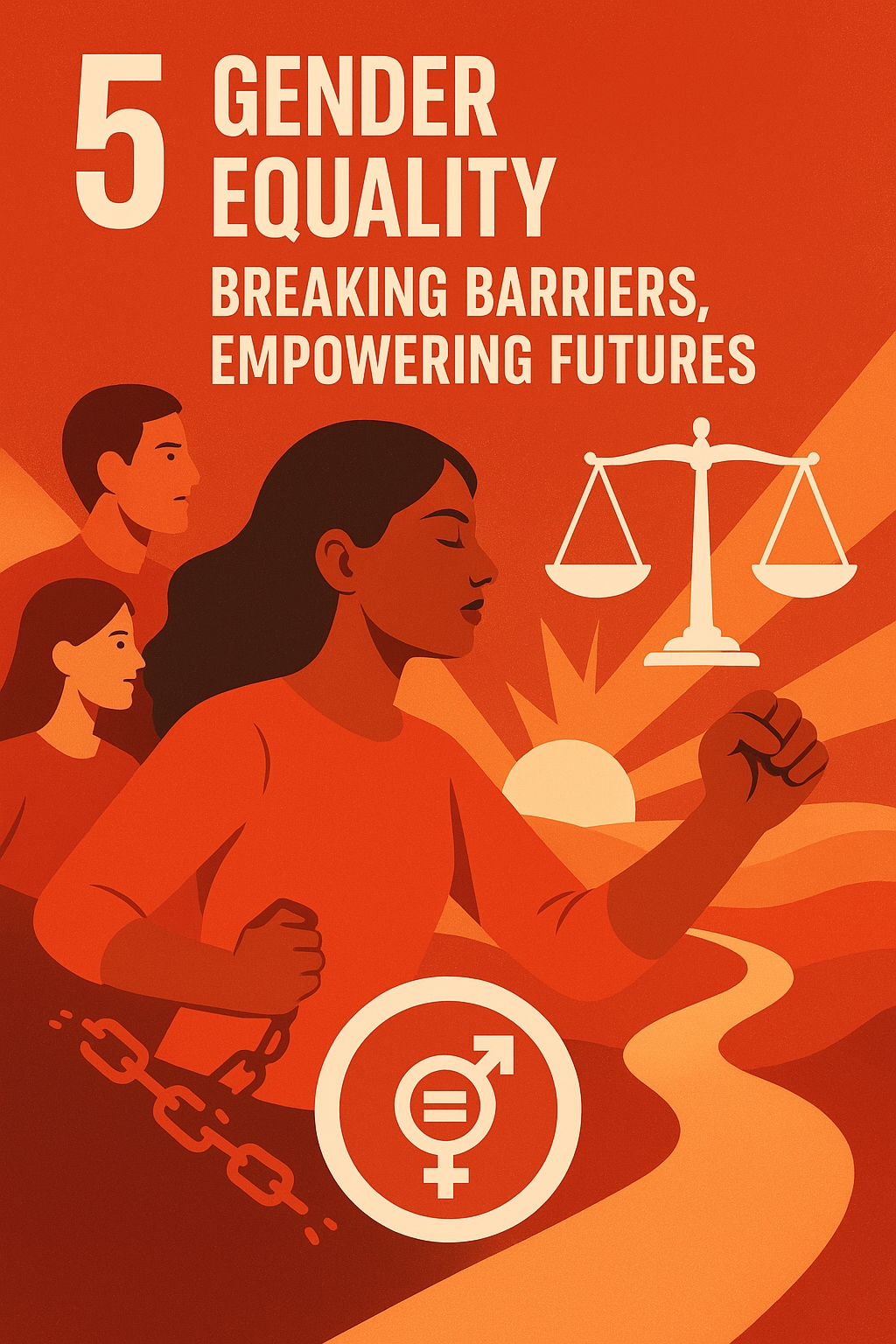SDG 5: Gender Equality — Breaking Barriers, Empowering Futures
Introduction: What Is SDG 5?
SDG 5: Gender Equality seeks to “achieve gender equality and empower all women and girls” by 2030. This goal acknowledges that gender justice is not only a human right but also a prerequisite for sustainable development.
The main targets include:
- Ending all forms of discrimination against women and girls everywhere.
- Eliminating violence, exploitation, and harmful practices like child marriage and female genital mutilation.
- Ensuring universal access to sexual and reproductive health rights.
- Recognizing and valuing unpaid care and domestic work.
- Guaranteeing women’s equal participation in political, economic, and public life.
- Reforming laws and policies to enforce equality in practice.
Gender equality is not charity — it is justice, dignity, and survival.
Why SDG 5 Matters Globally
Gender equality is the foundation of peace, justice, and prosperity. Globally:
- 1 in 3 women experiences physical or sexual violence.
- Women earn on average 20% less than men for the same work.
- Women hold only 26% of parliamentary seats worldwide.
- Unpaid care work done by women contributes trillions of dollars annually but remains invisible in GDP.
No country can progress while half its population is held back. Gender equality multiplies progress across all SDGs, from education and health to climate action and governance.
Pakistan’s Gender Inequality Emergency
In the context of Pakistan, discussions on gender equality must be understood within the framework of Islamic culture and tradition. Contrary to common assumptions, Islam grants women rights to education, property ownership, inheritance, and participation in public life—centuries before such rights were recognized in many other parts of the world. This foundation means that, in principle, Pakistan stands on stronger cultural and moral ground than many societies when it comes to recognizing gender equality.
Nevertheless, there remains a significant gap between principle and practice. Patriarchal social norms, uneven enforcement of legal protections, lack of access to quality education for girls in many regions, workplace discrimination, and underrepresentation of women in decision-making continue to hinder progress. Pakistan has made improvements—such as increased female enrollment in universities, women’s participation in the workforce, and political representation through reserved seats—but there is still much ground to cover to meet the targets of SDG 5 in both spirit and practice:
- Education Gaps
- Over 22 million children are out of school, the majority being girls.
- Rural girls face cultural barriers, early marriage, and lack of safe transport.
- Workplace Inequality
- Women’s labor force participation is just 22%.
- Gender pay gaps and glass ceilings persist in almost every sector.
- Informal and home-based work lacks protections or recognition.
- Political Underrepresentation
- Despite reserved seats, women face systemic exclusion from party leadership and decision-making roles.
- Female voter turnout remains lower in many regions due to cultural restrictions.
- Gender-Based Violence
- Domestic violence, honor killings, harassment, and trafficking remain rampant.
- Legal protections exist but enforcement is weak due to cultural stigma and institutional inertia.
- Cultural and Religious Misuse
- Patriarchal traditions are often reinforced through misinterpretations of religion.
- Women’s autonomy and mobility are curtailed in conservative communities.
Five Dimensions of the Crisis

- Legal and Institutional Gaps
- Progressive laws exist (e.g., Protection against Harassment Act), but implementation is poor.
- Parallel justice systems (jirgas, panchayats) often perpetuate discrimination.
- Education and Opportunity Deficit
- Schools for girls are fewer, often unsafe or underfunded.
- STEM fields and higher education remain male-dominated.
- Violence and Insecurity
- From street harassment to domestic abuse, insecurity limits women’s freedom.
- Reporting mechanisms are weak and survivors risk social stigma.
- Economic Exclusion
- Women entrepreneurs face barriers in accessing credit, land ownership, and markets.
- Unpaid domestic and care work remains invisible in policy frameworks.
- Cultural and Social Norms
- Male guardianship practices limit women’s choices.
- Media stereotypes reinforce secondary roles for women.
Is SDG 5 Viable in Pakistan’s Context?
Yes, but only with systemic reforms. Pakistan has strong women leaders, a young population, and increasing global support for gender equality. Yet:
- Investment in women’s development is minimal.
- Gender issues are politicized and often sidelined.
- Patriarchal structures and elite interests resist change.
Without serious cultural, institutional, and economic transformation, gender equality will remain an aspiration rather than a reality.
Economic Lens: Can Pakistan Afford Gender Equality?
Gender equality is not a cost — it is an investment. Studies show:
- Closing the gender gap in labor force participation could increase Pakistan’s GDP by 30% or more.
- Women entrepreneurs drive innovation and local development.
- Every additional year of schooling for a girl increases her future earnings by up to 20%.
Inequality costs more than equality.
Strategic Recommendations for Pakistan
The recommendations here are strategic options. They must be piloted locally, tested, and adapted before full-scale implementation. Cultural sensitivity, citizen participation, and political will are non-negotiable.
✅ 1. Legal and Institutional Reform
- Strengthen enforcement of existing laws against harassment, domestic violence, and honor killings.
- Abolish parallel discriminatory justice systems.
- Ensure gender budgeting in all ministries and provinces.
✅ 2. Universal Girls’ Education
- Build and secure schools for girls, especially in rural areas.
- Provide stipends, transport, and conditional cash transfers for families.
- Promote women’s inclusion in STEM and higher education through quotas and scholarships.
✅ 3. Economic Empowerment of Women
- Expand microfinance, credit, and training programs for women entrepreneurs.
- Ensure equal pay legislation is enforced across sectors.
- Recognize and account for unpaid care work in national economic statistics.
✅ 4. Political and Leadership Inclusion
- Strengthen reserved seats with real power and capacity building.
- Enforce minimum female representation in party leadership and local councils.
- Support mentorship and leadership programs for young women.
✅ 5. Combat Gender-Based Violence
- Establish fast-track courts for gender violence cases.
- Expand women’s shelters, crisis centers, and helplines.
- Train police and judiciary in gender sensitivity.
✅ 6. Cultural Transformation
- Engage religious scholars to reclaim authentic Islamic narratives of gender justice.
- Use media, drama, and social campaigns to challenge stereotypes.
- Involve men and boys as allies in promoting equality.
Conclusion: Equality as a Test of Justice
Gender equality is not only about women — it is about building a just and prosperous society. Pakistan cannot progress while excluding half its population. SDG 5 is therefore a litmus test for the nation’s justice, democracy, and development.
If Pakistan fails on SDG 5, it risks deepening inequality and instability. But if it succeeds, it will unleash the potential of millions of women and girls, creating a future of dignity, progress, and hope for all.

